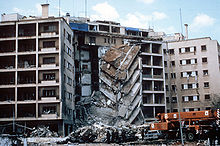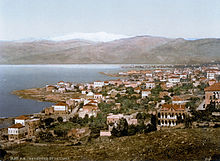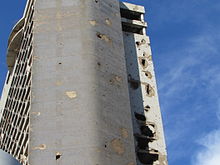Beirut
![]()
This article explains the city. For other meanings, see Beirut (disambiguation).
![]()
Berytus is a redirect to this article. For the titular archbishopric, see titular archbishopric of Berytus.
Beirut (ba͜iˈruːt, also ˈba͜iruːt, occasionally beiˈruːt or ˈbeiruːt, Arabic بيروت Bayrūt, dialect Beyrūt) is the capital of Lebanon. It is located on the eastern Mediterranean Sea, on the Levant coast, approximately in the middle of its north-south extension.
Beirut is the economic and cultural center of the country with many publishing houses and universities, including the American University of Beirut (AUB) and the Université Saint-Joseph (USJ). The city was often referred to as the "Paris of the Middle East" before the Lebanese Civil War (1975-1990).
Population
The exact population of the city is unknown, as the last census was conducted in 1932. In 1991, the number was estimated at 1½ million, and in 2012, 2,060,363 inhabitants were calculated for Beirut and the surrounding area. The State Department estimated the population at around 1½ million in March 2014. In recent years there has been an influx of refugees from Syria. For 2017, the UN estimates the population of the Beirut agglomeration at 2.3 million.
Population development of the agglomeration according to UN
| Year | Population |
| 1950 | 322.000 |
| 1960 | 561.000 |
| 1970 | 923.000 |
| 1980 | 1.623.000 |
| 1990 | 1.293.000 |
| 2000 | 1.487.000 |
| 2010 | 1.990.000 |
| 2017 | 2.332.000 |
Beirut is the most confessionally diverse city in the country and the Middle East. It is home to Christians (Maronite, Greek Orthodox, Syriac Orthodox, Syriac Catholic, Armenian Orthodox, Armenian Catholic, Roman Catholic and Protestant), Muslims (Sunni and Shia) and Druze. Almost all Jews have left Beirut since 1975. The exact percentage of denominations in the population is unknown because the denominational affiliation of residents was last surveyed in 1932. 50% were Christians (of which 30% were Maronites, followed by Greek Orthodox at 16%), 50% were Muslims, of which one-third were Shiites. It is possible that the majority of the population today is Muslim, including a majority of Shiites. The north of Beirut is predominantly Sunni and Christian. The east of Beirut is predominantly Christian, and the west is predominantly Sunni. The south of Beirut is predominantly inhabited by Shiites.
History
The earliest mention of the city dates to the middle of the 2nd millennium B.C. Beirut was already an important city-state under the Phoenicians; its ancient Phoenician name was Be'erot (Engl. 'well' (plural)). From this the Greeks called the city Βηρυτός (Berytós).
After the conquest by the armies of Alexander the Great, Beirut belonged for a long time to the Seleucid Empire. Its rule ended in 63 BC in the course of the conquest of the Levant by the Romans. Pompey made the area to which Beirut belonged a province of the Roman Empire as Syria. During the Roman period, the city, now named Berytus as a Roman colony, was very important and produced well-known jurists, including Papinian and Ulpian. The Beirut school of law was influential until the 6th century. At least until the late 4th century, probably considerably longer, Latin was the dominant language of Beirut; this set it apart culturally from its surrounding countryside. In 551, an earthquake and subsequent tidal wave destroyed the prosperous city.
In 635 Beirut was conquered by Arabs, who called it Bayrut. The city, still badly damaged, was rebuilt and trade began to flourish again. From 1110 to 1291 Beirut was in the hands of the Crusader states. It became important for European trade and had its own vassals within the principality of Galilee. After the conquest by the Christian armies, Beirut fell first to Fulco of Guînes; in 1166 Amalrich I gave it as a fief to Andronikos Komnenos, later Byzantine emperor, who, however, had to leave it after his love affair with Queen Theodora of Jerusalem became known. In 1197 John I of Ibelin was enfeoffed with the city, which was by then badly destroyed. After his death (1266) it fell to his daughter Isabella of Beirut. The crusaders also established a bishopric in Beirut and built a cathedral dedicated to John the Baptist, which is now used as a mosque. In 1291, the Kingdom of Jerusalem finally collapsed, ending the rule of the Crusaders.
After the reconquest of Beirut by the Muslims (Mamluks) in 1291 under Shujai, the city was mostly ruled by Druze, even after it fell to the Ottoman Empire in 1516. In 1888 Beirut became a vilâyet of Syria, comprising the sandshaks of Latakia, Tripoli, Beirut, Acre, and Bekaa. In 1895, the Lebanon Railway, the Beirut-Damascus railway line, was put into operation.
In 1912, Italian forces sank Ottoman ships in the naval battle of Beirut.
With the collapse of the Ottoman Empire after World War I, Beirut fell to France as part of a League of Nations mandate. In 1942, the Haifa-Beirut-Tripoli railway line was put into operation. After World War II, Beirut became the capital of the now independent Republic of Lebanon. Foreign investors were attracted by the Lebanese government's free trade policy, so that Beirut developed into an international financial centre. It was considered the Paris of the Middle East.
During the Lebanese civil war (1975-1990), the city was destroyed to a considerable extent. The front line ran right through the centre, dividing Beirut into the Muslim west and the Christian east. In June 1982, Israel invaded Lebanon; western Beirut was besieged and shelled for ten weeks (Lebanon campaign). Israel forced the Palestine Liberation Organization (PLO) to withdraw completely on August 21, under the supervision of a multinational protection force.
On September 17, 1983, the U.S. Navy shelled Syrian positions near Beirut for the first time. However, the multinational peacekeeping force left Lebanon in 1983 after two bombings of multinational headquarters attributed to Hezbollah killed 241 U.S. soldiers and 58 French on October 23, 1983. In 1985, Israel established a protection zone in the run-up to the Israeli border. A car bombing on March 8, 1985, targeting Shiite spiritual leader Sheikh Muhammad Hussein Fadlallah killed 80 people and injured 256. In October 1990, the civil war ended. The destroyed parts were largely rebuilt.
Before 1975, Beirut's city centre was a commercial and entertainment centre and an interdenominational meeting place. There was less public life in the predominantly confessional parts of the city. Downtown Beirut was a place of encounter and peaceful coexistence, for which the city had been a symbol for decades. In the first weeks of the war, the city center was highly destroyed in grueling street battles; over the years and fighting, it deteriorated into a wasteland and was an impassable no man's land, controlled by militias and snipers. Beirut's peculiar topography - the city centre lies in a hollow - meant that fighting in the city centre could be observed from other parts of the city.
During the 16 years of civil war there were numerous peace efforts as well as short or longer breaks in the fighting. The main fighting, and thus the most serious destruction, occurred in the city center and along the demarcation line ("Green Line") that separated West and East Beirut. Neighborhoods dominated by one religious affiliation segregated themselves from the other.
The Lebanese writer Raschid al-Daif described the mood of the Beirut population during the war as follows: "... The war then, however, was not a struggle of rich against poor, but of rich and poor against rich and poor. Palestinians fought among themselves, Syrians fought with Palestinians against Christians, then with Christians against Palestinians. Finally, Christians with each other and against the Druze, all with each other and against each other - who was to understand? [...] In the end we laughed at those who tried to analyze the conditions."
After 16 years of war, the younger inhabitants had no image of the inner city or the other side. Areas of the city without access had been 'blanked out' and new public spaces - e.g. trading places - had been created on their own side.
Religious segregation persists (as of 2004); some areas of Beirut have little overlap with other parts of the city.
The assassination attempt on Hariri in Beirut on 14 February 2005 killed 23 people, including Hariri.
On 13 July 2006, Israel attacked the city's airport during the 2006 Lebanon War. Many Lebanese were killed in this and other airstrikes; districts (especially in the south of Beirut), traffic routes and infrastructure were damaged or destroyed.
More than 40 people were killed in terrorist attacks on 12 November 2015. The Islamic State claimed responsibility for the attacks.
On 4 August 2020, an explosion disaster occurred in the port of Beirut, exploding 2750 tonnes of unsafe stored ammonium nitrate. This resulted in at least 190 deaths and more than 6,500 injuries, with damages amounting to several billion euros.

US embassy in Beirut destroyed by a bomb attack, April 1983

Beirut around 1900

Holiday Inn Hotel damaged in the early phase of the war in 1975/76 during the so-called Hotel Battle in the centre.
Search within the encyclopedia